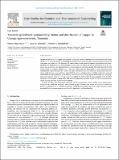Towards agricultural sustainability: Status and distribution of copper in Usangu agro-ecosystem, Tanzania

View/
Date
2022-02-28Author
Mng’ong’o, Marco
Munishi, Linus
Ndakidemi, Patrick
Metadata
Show full item recordAbstract
Despite the positive role of copper (Cu) in plants and animals, excessive amounts have environmental and health
effects. Cu has been excessively accumulating in agricultural soils worldwide due to increased agrochemicals and
wastewater use in farming. The increased Cu concentration in soil negatively impacts soil microbes and plants,
affecting crop productivity and environmental quality. Here, the status and spatial distribution of Cu in Tan zanian agro-ecosystem were characterized as its information are currently missing. The study assessed 198 soil
samples from 10 irrigation schemes and 3 land use, where total and bioavailable Cu were determined and
contamination status assessed. The variable Cu status and distribution were observed among studied land use
where paddy farming areas had higher total (5892.36 μg/kg) and bioavailable Cu (3342 μg/kg) than total and
bioavailable Cu concentration in maize farming areas (total Cu 1522.09 μg/kg and bioavailable Cu 779 μg/kg)
and conserved areas (total Cu 4415 μg/kg and bioavailable Cu 3267 μg/kg). The bioavailability of Cu for plant
uptake was 52% in maize farming areas, 49.9–63.5% in paddy farming areas, and 48.4–51.6% in reserved areas,
where farming areas had higher Cu bioavailability.
Contrary to other agro-ecosystems worldwide, all Cu concentration values studied in the Usangu agro ecosystem are within the acceptable limit (100000 μg/kg). However, this should not have to be taken for
granted or ignored; there is a need to set strategic management to maintain Cu levels in agro-ecosystem within
acceptable limits to ensure environmental quality, food safety, and sustainability.
URI
https://doi.org/10.1016/j.cscee.2022.100193https://dspace.nm-aist.ac.tz/handle/20.500.12479/1437
